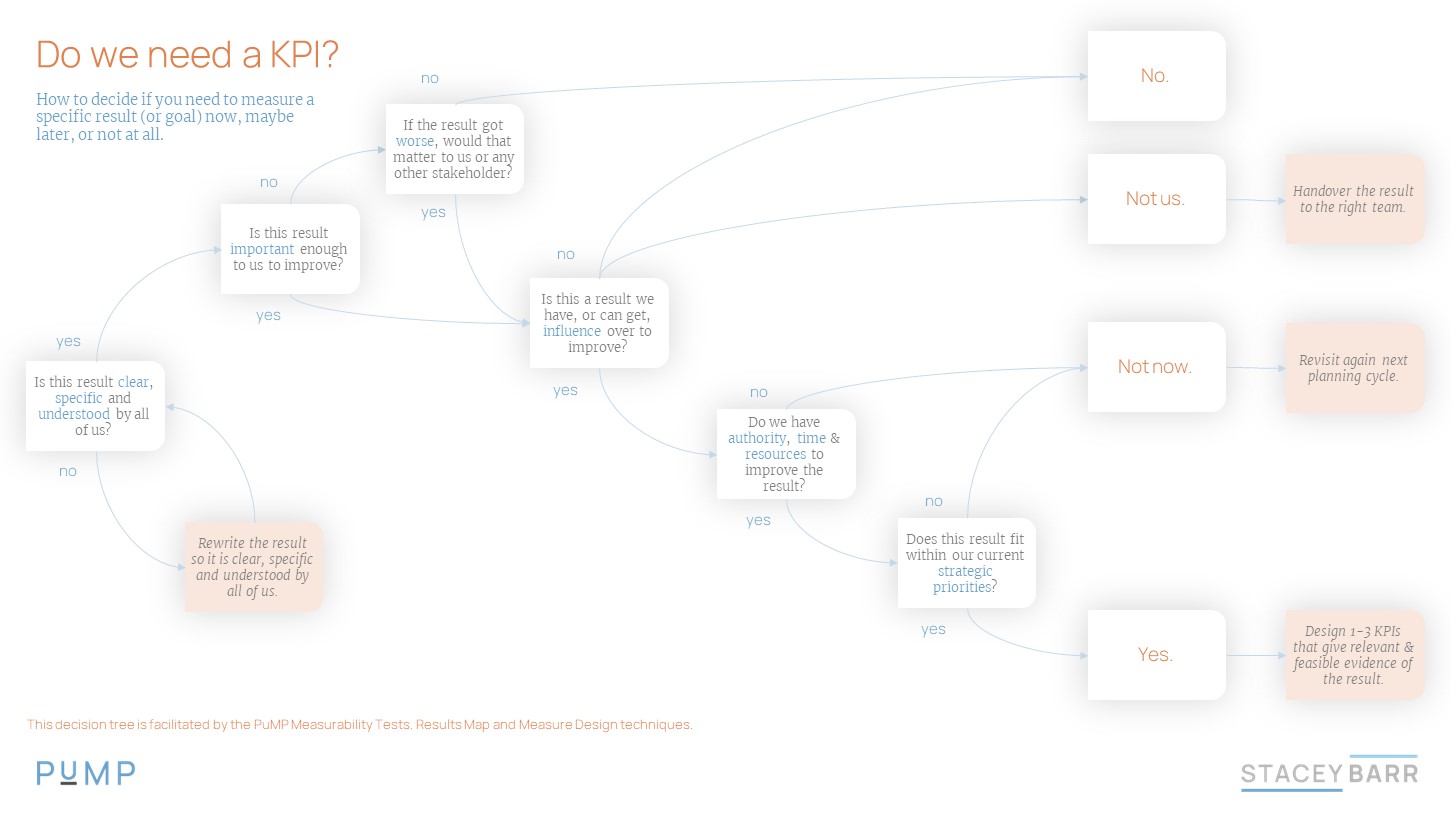Decision Tree: Do We Need a KPI?
by Stacey Barr |How to decide if you need to measure a specific result or goal now, maybe later, or not at all.

There are a few reasons why we measure things that aren’t very good reasons at all:
- Because we’ve always measured it.
- Because we have the data (it’s easy to measure).
- Because “they” measure it.
- Because “they” told us to measure it.
- Because we can’t manage it if we don’t measure it.
Reasons like this lead us to KPI overwhelm, rather quickly. Perhaps you’re already there! And not much insight or performance improvement comes from KPI overwhelm. We can get much bigger performance improvements when we focus on the measures that truly matter.
To help us decide which measures truly matter, we need to start with the results that really matter, and only measure those. And that’s what this PuMP Decision Tree can help you do:
[Click to view and download a larger image.]
Let’s walk through this decision process now, together.
STEP 1: Is this result clear, specific and understood by all of us?
Possibly the most challenging obstacle to deciding if, and how, to measure a result lies in how that result is written, or articulated with words. The more vague and ambiguous the words, the harder it is to understand what we’re trying to measure. (I reckon you could find at least one goal like this in your strategic plan – why not take a look?)
If your result or goal is not clear, specific and understood by everyone, spend some time to rewrite it in results-oriented language that a 10-year-old could understand. These are the first two of PuMP’s Measurability Tests. Try them out here:
- How to be more results-oriented: Replace Your Action-Oriented Goals With Result-Oriented Goals
- How to be more specific and understandable: Why You Can’t Measure Your Performance Outcomes
When you’ve rewritten your result or goal, check again if it’s clear, specific and understood by everyone. Sometimes this step can be a bit iterative, but it’s worth it! When it’s good to go, we can move to STEP 2.
STEP 2: Is this result important enough to us to improve?
None of us has the time to do everything. None of us can afford the indulgence of treating everything as though it matters. Peter Drucker says the key to strategy is omission. And that extends to needing to be ruthless about what to measure!
Doesn’t it make sense to measure only the results or goals that are important enough to improve? Why measure something if we aren’t interested in changing it? (Well, there is one more reason, but that’s the next step in our decision process.)
This is also part of another of the PuMP Measurability Tests: should we improve this? If our answer is no, we move onto STEP 3, up next. If our answer is yes, we can jump to STEP 4.
STEP 3: If the result got worse, would that matter to us or any other stakeholder?
We arrive at this step if we have a result that isn’t important enough to improve. But perhaps, even though we don’t need to make it perform better, we’d be worried if it got worse. Or another stakeholder would be worried. For example, our customer response times might always be within our promised window, but we’d want to know if it started to slide.
In PuMP, we refer to these types of results as business-as-usual results (this Universe of Measures map might help). We might monitor them with measures, but only to be alerted if they head the wrong way. Often, they’re already measured by one or more KPIs.
If it really doesn’t matter if the result got worse, then we stop there and don’t bother measuring it. But if the result getting worse does matter to us, and it doesn’t have a good enough KPI yet, we can take it to STEP 4.
STEP 4: Is this a result we have, or can get, influence over to improve?
There are certainly times when people feel they can’t measure something because it’s not within their control. But when you really think about how interconnected organisations are, we’re not in full control of much at all. It’s more useful to think about influence, not control.
One of PuMP’s greatest fans, Jerry Stigall (now retired and spending his time trout fishing), wrote about this tension between control and influence here: Influence (or Impact) Versus Control. Jerry also gives some very practical ways to help your team test if they do, in fact, have more influence over a result than might first have assumed.
This is another part of the PuMP Measurability Tests: can we improve this? If our answer is no, we don’t bother measuring it, but instead hand it over to the team that can influence this result. But if our answer is yes, we move to STEP 5.
STEP 5: Do we have authority, time & resources to improve the result?
Just because we can have influence over improving a result, or stopping it from declining in performance, doesn’t mean we can exercise that influence. If we aren’t given the authority, by leadership, for example, to take on the improvement, it won’t happen. If we don’t have spare budget or time to take on the improvement, it won’t happen.
No matter how important it might seem to improve a result, we will not improve it if we don’t have the authority, resources, and time to allocate to it. We cannot just hope to fit it in. Spreading ourselves too thin means we are, at best, mediocre at a lot of things. But if we ruthlessly prioritise and realistically commit, we can achieve excellence.
And so, as another part of the PuMP Measurability Tests, we ask this question: will we improve this? If our answer is no, we don’t bother measuring it, not yet anyway, but keep it in the pipeline for our next planning cycle. If we answer yes, we move to STEP 6.
STEP 6: Does this result fit within our current strategic priorities?
Hopefully by the time we’ve reached this point in our decision process about whether or not to measure our result, we probably going to measure it. But one last check is worth making. That’s because we have such a strong tendency to take on more than we should when it comes to measuring stuff.
This final check is to make sure that our result fits into our strategic priorities. That means that it aligns to what is important for our organisation as a whole. It means that the success of our organisation’s current strategy and purpose will be in jeopardy if we don’t measure and improve this result.
In PuMP we have the Results Map technique to help us see how the result fits in and aligns to strategic priorities. Can we logically fit the result into a strong cause-effect relationship to other known important results? If our answer is no, then now is not the time to spend effort measuring this result, and we’ll consider it again in the next planning cycle. But if our answer is yes, we measure it.
What next?
If this decision process led us to the decision to measure our result, we need to make sure we find the best one to three KPIs for it. These KPIs need to be direct evidence of the result, balanced with being feasible to implement. To do this, for each result we decided to measure, we move onto the next technique in PuMP, which is Measure Design. Here’s an introduction for you to play with: Five Steps for How to Find The Right Measures or KPIs
Do you feel better equipped to decide which results or goals are worth measuring now, not yet, or not at all?
Connect with Stacey
Haven’t found what you’re looking for? Want more information? Fill out the form below and I’ll get in touch with you as soon as possible.
167 Eagle Street,
Brisbane Qld 4000,
Australia
ACN: 129953635
Director: Stacey Barr





